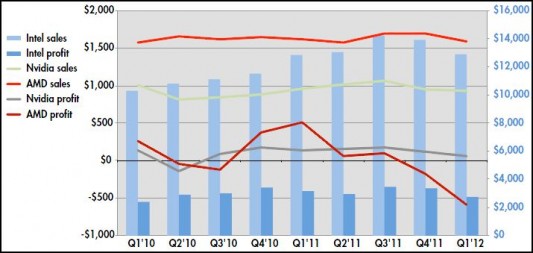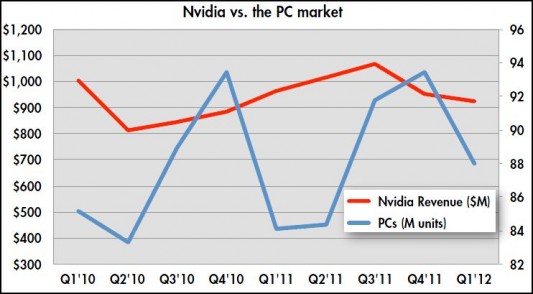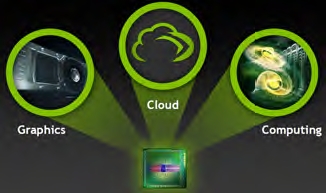Pay attention to the company behind the screen. An overview of Nvidia’s recent growth and current prospects.
By Jon Peddie
[Editor’s Note: This article is an excerpt from a more detailed article in the current issue of Jon Peddie’s TechWatch from Jon Peddie Research.]

Nvidia is probably, and rightfully, best known for its success in the PC gaming market, but the company actually drives more screens and more types of screens than any other firm. No other company drives mobile phone, tablets, netbooks, laptops, desktops, workstations, automobiles, planetariums, CAVEs, game consoles, signage, and indirectly, cinema screens—from the tiniest to the largest. About the only screen Nvidia isn’t driving is TV, and that may just be a matter of time; however, the company is driving broadcast TV systems.
In addition to driving almost every imaginable screen, the company has also moved into high performance computing (HPC) with GPU-based parallel processors; soft modems to complement its ARM-based application processor SoCs; virtual GPUs in the server room and in the cloud; and moved out of chipsets. As a result, the company has an almost bewildering list of products. Despite all that, the stock market has not rewarded Nvidia for its efforts.

The development of new products and a killer marketing team have keep Nvidia fairly well sheltered from the vicissitudes of the PC market. And yet, with billions poured into R&D, hundreds of millions into acquisitions, and an almost non-stop creation of profits, the company seems to be stuck in the $4 billion sales range—a level it hit in 2008—and its share price wobbles in the mid-teens. In addition, the company never stopped hiring, so its revenue per employee has dropped; Nvidia’s revenue per employee is now in line with its competitors.
The company is somewhat a victim of its own success. It virtually owns the professional graphics market with 95% market share, and it is the dominant supplier in the games market with an 80% market share; overall, its PC GPU business holds a commanding 55% (Q1’12). But that’s not news, and once you reach such staggering proportions of market share, it’s hard to grow faster than the market. Nvidia has done remarkable things to make the markets grow, the latest being Maximus, which marries a Tesla compute board with a Quadro display board to give the user real-time rendering and editing. It also has pushed the gaming market with physics, clever anti-aliasing techniques (a new one every year it seems), and clever load balancing in notebooks and now Ultrabooks with its Optimus concept. Its latest development, GeForce Grid, promises to bring cloud-based GPU performance to any platform including tablets, and VGX offers GPU power to anyone in a LAN who needs more GPU power than he or she currently has.
All those efforts keep the company ahead of the curve and help create new users and open up new markets. But the big-bang theory for Nvidia has been the mobile world, which includes automobiles, mobile phones, and tablets offering a potential market of billions of units, compared with hundreds of millions for PC (including workstations and servers). And Nvidia has been trying to punch into that arena since 2003.
It wasn’t as easy as they thought it would be, not dealing just with the huge entrenched incumbents but also their customers, the carriers, and the multitude of regulating agencies throughout the world. Nvidia wasn’t alone in its frustration about breaking into the mobile market—AMD tried and gave up, and Intel has tried about as long as Nvidia. Nvidia has done better than the others and racked up dozens of design wins in all three platforms (automotive, mobile phone, and tablet) but still hasn’t been able to get close to the big boys like Apple, Qualcomm, Samsung, and TI. Nvidia will (or already has) passed ST-Ericsson, Marvell, Renesas, and others who participate in the application processor world. However, it has to look over its shoulder because Intel is on the same trail.

In addition to the technology, Nvidia has built a golden brand and cachet. That brand has gotten them into major accounts and helped position them as a player in the mobile market. But the product didn’t meet the expectations of some of their customers, which proved to be an embarrassment for Nvidia and an opportunity for their many competitors, not the least of which is their supplier/partner, ARM.
Nvidia is no quitter; when Tegra 1 didn’t amaze customers, and Tegra 2 came in a little short, Nvidia rolled out Tegra 3 and showed a road map that goes on for years. And to add to the mix, the company has added a fully integrated unit with application processor and modem code-named Wayne (in keeping with its super-hero themed Tegra code-names) that it plans to roll out in 2013. In 2011 Nvidia sold $360 million worth of Tegra, and they are forecasting they will do over $500 million in 2012. The company expects the rollout of Windows RT to help move that number.
Nvidia has been plowing its profits back into R&D and market development for the mobile business. It’s been a delicate balance to keep the profit level up while developing a new business.
In addition to mobile, Nvidia is investing in a super ARM-based chip (Project Denver), which the company plans to use as an entrée into the low-end server market and maybe the low-cost HPC market. Dell and HP are already in that market, and other ARM licensees are entering it, too.

What’s a successful company to do?
So with all that good stuff going on, you’d think the stock market would be going as nuts over the company as they do over Apple.
And they still might. The company has a lot of cash (over $3 billion, compared to AMD with $1.7 billion) to support its R&D and future acquisitions, and it’s got multiple product lines all with good (some great) margins and, as mentioned, a killer brand backed up by a formidable marketing machine.
However, life isn’t going to be easy in the mobile area when you have competitors like Allwinner and TI offering a system on a chip (SoC) with GPU for $5 to $7, and Qualcomm with maybe more design wins than all others combined.
We think Nvidia has a great future and lots of potential, and is going to have a difficult time convincing the sharpshooters on Wall Street to see that potential.





